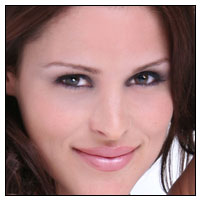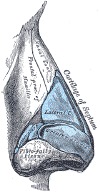When Your Nose Doesn't Work Well: Septoplasty, Turbinectomy and Deviated Septum Surgery

Rhinoplasty can be performed for medical reasons to relieve breathing problems or for cosmetic reasons. For more information about cosmetic nose surgery, visit our sister website. The primary function of the nose is to breathe efficiently and comfortably. That sounds pretty basic, but many people have breathing problems with their nose, both during the day and at night, at play and at rest. Breathing problems of the nose and sinuses can cause headaches, pain, anxiety, and depression, and can interfere with participation in many activities.
Because the nose is often broken, some nasal problems are caused by scar tissue that partially or fully blocks the airways. A build up of scar tissue can also cause the more minor, but potentially embarrassing, whistles, and other noises during breathing.
Scar tissue can also cause rhinorrhea, excessive mucus secretion from the nose, which I have. This is where mucous membranes in the nasal cavity, turbinates, or sinuses produce an excess amount of mucus or fluid that drips constantly, but that is not caused by inflammation due to allergies or infections. This scar tissue may be the result of a broken nose, surgery, or infection. It happens. Although it is very common to have rhinorrhea for several months after a rhinoplasty, mine has lasted several years now.
A constantly drippy nose can also be caused by allergies, so you do have to have your nose checked out by a physician (especially an otolaryngologist, who specializes in disorders of the ear, nose, and throat) to find out if it is caused by scar tissue or some other obstruction. The physician will take a swab of your nose and check for immunoglobulin, which would indicate an allergy. If it is due to obstruction, a septoplasty or turbinectomy may be able to help.
Some people (me included) get gustatory rhinorrhea, which is a runny nose while eating. This is downright annoying. I always have to have a Kleenex on my lap white eating, especially if it is Thai or Mexican food due to the spiciness.
Deviated Septum and Correction Surgery
One of the most common reasons for noncosmetic nose surgery is a deviated septum. The septum is the vertical wall between your two nostrils that extends back into the nasal cavity. This wall can be twisted and crooked, and be deviated out of its normal position. This deviation results in a smaller nasal passage on one side or the other, or even on both.
Even if your septum is nice and straight, you may have extra mucosal tissue, cartilage, or scar tissue and sometimes even bone that may be blocking or partially blocking one of your nostrils. A deviated septum can also cause a nose to be crooked, if the deviation is from birth or early childhood. The septum grows crookedly as the child ages and pulls the nose out of alignment.
Not only can a deviated septum wreak havoc on your ability to breath through your nose, if it is severe enough it could contribute to repeat sinus infections. If you need sinus surgery, but the surgeon has difficulty getting tools and instruments into the sinus cavities, it is possible that you will need a septoplasty as well.
If you have a slightly deviated septum, don't fret. There are very few people in the world with a perfectly straight septum. And many people have a deviated septum that does not give them any problems.
 |
 |
 |
CAPTION: The Structure of the Septum
What Is Septoplasty?
The most common surgery for a deviated septum is septoplasty. A septoplasty can straighten a deviated, twisted, bent, or crooked septum to improve breathing, reduce the incidence of nasal and sinus infections, and increase comfort. Septoplasty, which is one form of rhinoplasty, can also provide some cosmetic benefits when done in conjunction with other work on the nose. Many people go their entire lives never knowing that their difficulty breathing through the nose could be corrected with a septoplasty.
Are You a Candidate for Septoplasty?
Many may think they are "stuffed up" all the time due to allergies but actually have a deviated septum. If you have recurrent problems breathing through your nose or repeated sinus infections, you should be seen by a board-certified otolaryngologist; an ear, nose, and throat specialist, commonly called an ENT. An ENT doctor can examine you and diagnose your problem. If your breathing is affected, your rhinoplasty may be covered by your health insurance.
If you are having difficulty breathing, either constantly or frequently, on just one side of your nose or both, again, you should be evaluated by a board-certified ENT. You may have a deviated septum, but there are other problems that can cause breathing problems, so getting a diagnosis from an ENT is important. There are ENTs who specialize in rhinoplasty, including cosmetic rhinoplasty. Plastic surgery of the head and neck is a subspecialty in otolaryngology.
One clue that you might need to see a physician about your nose and your breathing is if you are using nasal sprays on a daily basis. The buffered saline sprays are fine, since these are not medicated. You should never use a medicated over-the-counter nasal spray for more than a few days at a time. If you feel the need to use these sprays for more than a week, you should definitely see a doctor.
Overuse of these sprays could damage your mucosa and aggravate the problem. Many of these sprays contain ingredients that can cause your nasal lining to swell once you stop using them, which makes you feel congested and then you start using the spray again, which sets up a nasty cycle. If you truly feel that you need a daily spray ask your doctor and he recommend one or two you can safely take.
How Septoplasty or Deviated Septum Surgery Is Performed
If a septoplasty is the only procedure being performed, it is almost always performed with a closed rhinoplasty technique, which means that the incisions are made inside the nose. It usually takes about 1 to 1½ hours.
If septoplasty is being performed in conjunction with a rhinoplasty, there may be additional, visible incisions at the bottom of your nose. The nose surgery may take an extra hour or more for difficult cases. Find out what incisions your surgeon will use beforehand.
Septoplasty is usually performed under light sleep sedation or local anesthesia with light sedation in pill form (Valium), but your surgeon may prefer general anesthesia. Find out your surgeons preference before your surgery.
An incision is made in the mucous membrane lining of the nose, called the mucosa. The septum is made of cartilage at the bottom of the nose and bone above that. Sections of deviated and/or damaged and twisted septum may have to be removed. After the cartilage and/or bone are molded into the correct shape, the mucosa is sutured back into place. Your surgeon will usually pack your nose with nasal packing, made from a lubricant-coated piece of gauze that may have straws or plastic tubes for breathing and stability, or foam blocks. Packing helps keep the cartilage and septum in its new position for the first few days or a week. While the packing is in, you will feel stuffed up.
Turbinectomy: Surgery For Breathing Obstruction or Other Afflictions
Turbinectomy is a nose surgery to remove part of the turbinate structures (both bone and soft tissue) in the nasal cavity. The turbinates can become enlarged due to trauma or infection and can block breathing and drainage of the sinuses. Turbinectomy is done to open up the nasal airway and improve breathing by removing some or all of the turbinates.
It is important to try other measures before resorting to turbinectomy, but sometimes, you really have no choice. But be sure that removal of some or all of the turbinates is what you really need. Once these structures are removed, they don't grow back! There is a condition called empty nose syndrome, caused by the removal of too much of the turbinate structures. Some patients have complained of headaches, depression, dryness, nasal bleeding and sinus problems after their turbinectomy. All of your options should be researched before you commit to a turbinectomy.
However, a properly performed turbinectomy can greatly relieve many problems associated with nasal obstruction. Complications are relatively rare.
There are several ways to perform a turbinectomy, the most common being manual resection where the extra mucosal tissue is removed using surgical scissors. This minor resection is often called "turbinotomy" or "conchotomy."
 Turbinoplasty of the lower two turbinates is also an option and is a little more detailed and invasive, but is very effective for blockage. Bone and a mucosal flap are removed. The submucosal inferior turbinate can be removed as well, as its prominence can obstruct breathing as well.
Turbinoplasty of the lower two turbinates is also an option and is a little more detailed and invasive, but is very effective for blockage. Bone and a mucosal flap are removed. The submucosal inferior turbinate can be removed as well, as its prominence can obstruct breathing as well.
None of these procedures are simple, noninvasive operations. Postoperative bleeding is common, as well as dryness. The dryness can be relieved with a buffered saline wash or unmedicated saline nasal spray. Your surgeon may prescribe a medicated spray, however.
Don't expect instant relief. Breathing can actually be worse within the first few days to weeks after your surgery due to swelling. Once the swelling has gone down, you should be able to breathe easier.
